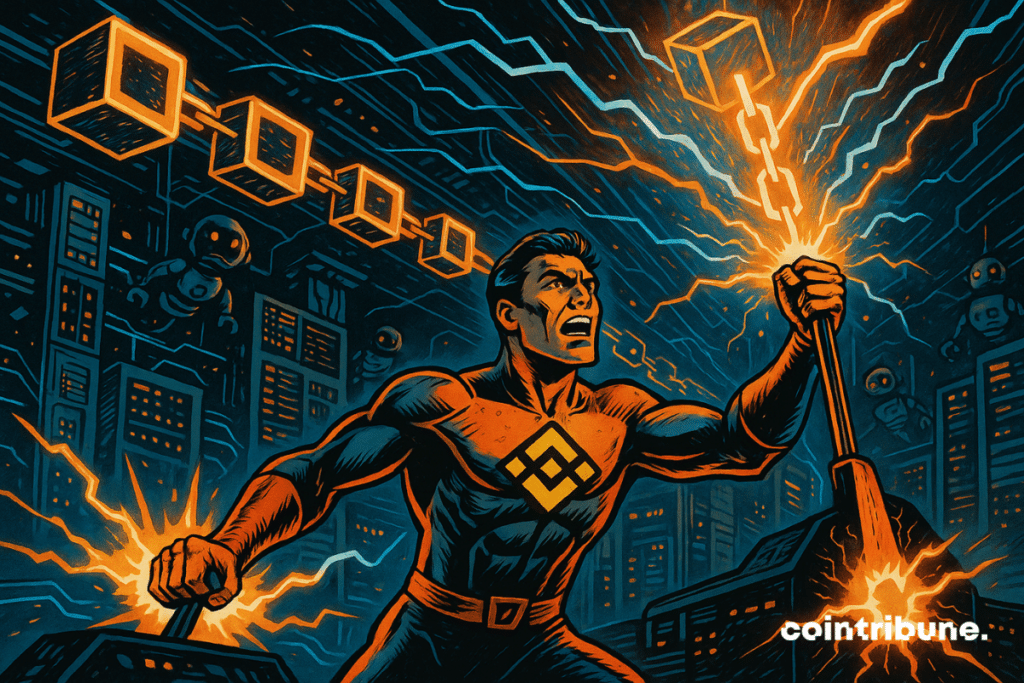The Maxwell Hardfork is going live on BSC mainnet.
— BNB Chain Developers (@BNBChainDevs) June 26, 2025
This isn’t just another upgrade—it’s a technical leap forward for faster blocks, better validator coordination, and smoother network performance.
Here’s what’s changing 🧵👇 pic.twitter.com/TFWQR0DZ0j
A
A
Maxwell Boosts Speed And Performance On BNB Chain
Tue 01 Jul 2025 ▪
5
min read ▪ by
Getting informed
▪
Centralized Exchange (CEX)
Summarize this article with:
The BNB Smart Chain is accelerating and scaling up. Since June 30, the Binance blockchain processes a block every 0.8 seconds thanks to the Maxwell update, a technical leap that brings it closer to the fastest standards in the sector. Behind this evolution is a clear goal: to remain competitive in the face of the intensifying performance race in DeFi. At a time when every millisecond counts, the BNB Smart Chain asserts its determination to dominate a Web3 where speed dictates adoption.

In Brief
- The BNB Smart Chain activated its Maxwell update on June 30, reducing block time from 1.5 to 0.8 seconds.
- Three technical proposals (BEP-524, BEP-563, BEP-564) support this acceleration, targeting speed, network synchronization, and stability.
- Developers are called to adapt their DApps to the new timings to avoid functional errors linked to timing.
- If the ecosystem adapts successfully, this technical advance could redefine BNB Smart Chain’s competitiveness in the market.
Maxwell : An Update to Accelerate the Core of the Network
While Binance had already deployed Pascal to boost the performance of its blockchain, on Sunday, June 30, the Maxwell upgrade was activated on the BNB Smart Chain, immediately reducing the average block time from 1.5 to 0.8 seconds, as confirmed by BscScan’s data.
The development team hailed the event as a significant breakthrough: “this is not just an update, it is a major technical advance for faster blocks, better coordination between validators, and smoother network performance”, said the project leaders.
This evolution fits into a trajectory that began last April with the Lorentz hard fork, which had already reduced block time from 3 to 1.5 seconds.
The deployment revolves around three technical proposals integrated into the hard fork, aimed at strengthening the network’s speed, stability, and synchronization :
- BEP-524 : directly lowers the block production time, the main goal of this update ;
- BEP-563 : improves communication between validators, reduces missed vote risks, and speeds up block propagation ;
- BEP-564 : introduces two new types of network messages (GetBlocksByRangeMsg and RangeBlocksMsg) to optimize block retrieval and distribution on the network.
These improvements are not merely cosmetic: they aim for better overall network efficiency, faster consensus cycles, and enhanced resilience in synchronization processes.
As the official documentation recalls, these measures are essential for targeting the “critical 0.75-second threshold” while minimizing propagation or validation delays.
A Challenge for Developers and Validators of the Ecosystem
While reducing block time might seem abstract to the average crypto user, its consequences are very tangible for the technical actors in the crypto ecosystem of Binance, primarily developers and validators.
Before deployment, the BNB Chain warned: “developers must test their DApps under shorter block conditions, refactor any code dependent on the 1.5-second interval, and review any logic based on timing”.
The message was clear: any post-upgrade instability would be the responsibility of the applications, not the network itself. On the validators’ side, the chain asked them to synchronize their systems to support a 0.75-second cycle and prepare for a significant increase in inter-node communication load.
This change of pace therefore requires a revision of technical architectures, both for DApps and validator nodes. Special attention is needed to manage the consequences of this new timing, especially in smart contracts that use delays or time intervals to orchestrate crypto transactions.
In this context, the coming weeks will be crucial for identifying possible bottlenecks or breaking points in the application ecosystem.
Beyond technical considerations, this evolution could mark a strategic realignment of the BNB Smart Chain towards crypto use cases increasingly demanding in terms of latency, such as high-frequency trading or complex DeFi applications. If the infrastructure delivers on its promises of stability, Maxwell could position BNB Chain as an essential reference for developers seeking speed and smoothness. However, this technical ambition comes with an imperative: the entire ecosystem will have to keep pace. Otherwise, promises of speed might be hindered by peripheral weaknesses.
Maximize your Cointribune experience with our "Read to Earn" program! For every article you read, earn points and access exclusive rewards. Sign up now and start earning benefits.
A
A
Diplômé de Sciences Po Toulouse et titulaire d'une certification consultant blockchain délivrée par Alyra, j'ai rejoint l'aventure Cointribune en 2019. Convaincu du potentiel de la blockchain pour transformer de nombreux secteurs de l'économie, j'ai pris l'engagement de sensibiliser et d'informer le grand public sur cet écosystème en constante évolution. Mon objectif est de permettre à chacun de mieux comprendre la blockchain et de saisir les opportunités qu'elle offre. Je m'efforce chaque jour de fournir une analyse objective de l'actualité, de décrypter les tendances du marché, de relayer les dernières innovations technologiques et de mettre en perspective les enjeux économiques et sociétaux de cette révolution en marche.
DISCLAIMER
The views, thoughts, and opinions expressed in this article belong solely to the author, and should not be taken as investment advice. Do your own research before taking any investment decisions.